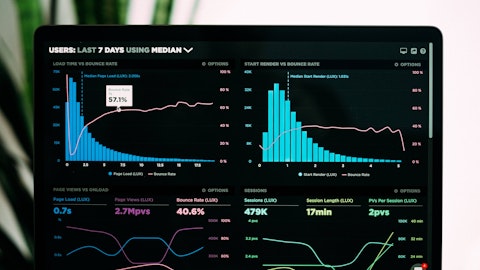Stephen Wyremski: I mean there’s a few things you need to consider there is that, as Eric just talked about, from a deposit standpoint, it’s going to be challenging. And if we’re planning on reducing deposits in the digital space, $3 billion to $5 billion, we certainly will then need to borrow in the short term, which then should lead to NIM and NII compression given the higher cost deposits as we saw towards the end of the fourth quarter. So we continue to expect some short-term pressure there. And then as we head into the end of the year, we should then see some relief is what we’re hopeful for and then see NIM expanding and also see some relief from the borrowing standpoint as we see some traditional deposit inflow. So I mean that’s the context that I would give in relation to your question there.
Manan Gosalia: Got it. That’s helpful. And then maybe on the expense side, I know you’ve spoken about expense growth being at around 20% or so as you invest in the business. But do you have some more room there to offset some of the pressure you’re seeing on NIM?
Stephen Wyremski: So there’s a few things to mention on expenses. For the first quarter, we do expect to be in the mid-20s again, it’s roughly 25%. We would have been lower had the FDIC not increased its assessment rates. They’re increasing every institution, 2 basis points, which for us means about $5 million a month in incremental expense – sorry, per quarter in incremental expense. So that is a headwind. Without that, we would have been in the low 20s. So first quarter, mid-20s, 25%, and then we should trend through the remainder of the year down to the high teens.
Manan Gosalia: Clear. Thank you.
Operator: We’ll take our next question from Bernard von-Gizycki with Deutsche Bank.
Bernard von-Gizycki: Yeah. Hi, good morning. You know, given your…
Joseph DePaolo: Good morning.
Bernard von-Gizycki: Good morning. So given you’re exiting a large amount of your crypto-related deposits. Just curious how this impacts the Signet platform. If you’re doing less volumes now, I would assume the activity volume-driven expenses should be coming down as well. I’m just trying to get a sense, like we’re focused on the funding part. So one is like the expense part, I think the discussion about the lower expenses in the later part of the year, it might be part of it. But any sort of fee income that could go away as we kind of consider this with these two factors as well?
Stephen Wyremski: We’re really looking at concentrations in that space. So we’re not necessarily exiting client relationships there, but we are lower in concentrations there. And that’s – so we’re seeing volumes in Signet – actually, volumes last quarter were the highest we’ve seen even as we were exiting these later in the year. So we don’t really expect much of effect on the Signet volumes. There’s really not much of a cost for us to operate Signet. So we’re not going to see any cost benefit there if we get volumes did come down in that space. From a fee income perspective, same answer, really, we’re not exiting client relationships really. So we’re not going to see much of a change in our foreign exchange and other sources of fee income there. So ultimately, all we’re doing is limiting the amount that clients can maintain in overall deposits at our institution and looking to have more of a granular deposit base, which will allow us to manage liquidity tighter.
Bernard von-Gizycki: Okay. Thank you. Just to follow up. I know obviously, the digital ecosystem is the largest on Signet, and you guys have alluded to other ecosystems like payroll, trucking, shipping, that could be utilized. Just trying to get a sense, like as we think of the other like non-crypto areas of the bank, are you seeing any sort of growth in those particular ecosystems, is there any way you can help like size, like what the second largest is on Signet, just to get a sense of you might have other areas that could grow and could be an area of focus? And if not, what kind of like catalysts should we kind of like think about it in those areas that could be growth if not this year, in outward years?
Eric Howell: Well, the video is actually – the number of transactions on Signet is actually digital is number two, not in dollars because they have large dollars, but we have the shipping industry, cargo shipping industry that is number one on Signet for a number of transactions. And then we payroll, which is starting to take course and we’re getting more payroll companies on. So the key for us is that we find these other ecosystems because we put a payment platform together 24 hours, 365 days a year. And the idea being that we want to attract as many ecosystems as we can to make it beneficial for us and the clients. What we did put together was something that the digital world embrace blockchain technology. And that’s why there is number one in terms of dollars that flow in and out.
But let’s face it. I mentioned that I didn’t think that crypto would be in the top 10 once we had other industries embrace blockchain technology. One of our shareholders said it probably would not be in the top 100. So it’s just a matter of educating both out there. We look forward to having more non-digital ecosystems, and we’ll just through everybody’s prohibition towards .
Operator: Thank you. And we’ll take our next question from Casey Haire with Jefferies.





